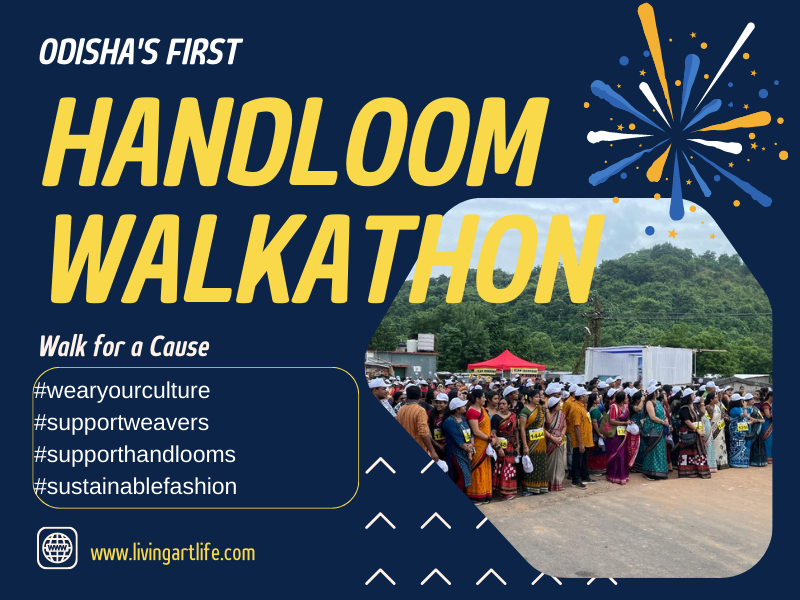National Handloom Day is observed on August 7th each year in India. It was inaugurated on August 7, 2015, by the Indian Prime Minister, Narendra Modi, to celebrate and promote the rich tradition and culture of handloom weaving in the country.
This year on 6th August 2023 Odisha celebrated the National Handloom Day by organizing a Handloom walkathon.
On the occasion of National Handlooms Day, 7th Aug Swabhimaani Odia Women’s World, SOWW has celebrated a Handlooms Walkathon in capital city Bhubaneshwar, Odisha .
This walkathon was the first of its kind in history of Odisha. It’s goal was to support the artisans and weavers of the state and promote the handlooms worldwide.
It was a walk of 3km with men and women wearing handlooms of different districts and cities of Odisha. The venue was Shikharchandi Square to Infocity, BBSR.
More than 700 people participated in the Odisha Handlooms Walkathon 2023. Everyone above 12 years had participated in the event.
The walkathon was energetic, enthusiastic and colourful with lovely saree drapes. Females and Males all wore handloom weaves from many different places of Odisha.
To name a few weaves of Odisha, they are Kotpad Handloom , Orissa Ikat or Bandha , Khandua, Gopalpur Tussar Fabrics, Sambalpuri, Bomkai, Habaspuri, Berhampur Patta, Pattachitra on Tussar silk, Dongria, Pasapalli, Bichitrapuri, Santali, Sonpuri, Dhalapathara Cotton, Hazarbutti, and many more.
How many of these do you know???
This was made possible by Swabhimani Odia Women’s World in association with Parichay Foundation, Lions Club and Spandita. The slogan was #wearyourculture.
The sunday morning started with a Zumba session to energize the participants , then the Walkathon and followed by breakfast and certificate distribution.
Many celebrity guests of the state also participated to be a part of this cause and celebrate the glory of Handlooms.
This day holds significant importance as it commemorates the Swadeshi Movement that was launched in 1905 as a part of India’s struggle for independence from British rule. The Swadeshi Movement aimed to promote the use of locally-produced goods, Indian handicrafts and boycott foreign-made products to support indigenous industries, including handloom weaving.
On National Handloom Day, various events, exhibitions, workshops, and seminars are organized to raise awareness about the significance of handlooms, promote their usage, and support the weavers and artisans who continue to preserve this ancient craft. The celebration aims to highlight the unique beauty, intricate craftsmanship, and cultural heritage associated with handloom textiles in India.
Yes, handloom textiles are considered sustainable and eco-friendly compared to mass-produced machine-made fabrics. There are several reasons why handlooms are regarded as a sustainable option:
- Environmentally friendly production: Handloom weaving involves a manual process that requires minimal use of electricity and no harmful emissions, making it an eco-friendly alternative to mechanized textile production.
- Reduced carbon footprint: Handloom weaving does not rely on large-scale factories or heavy machinery, leading to lower energy consumption and reduced carbon emissions.
- Preservation of traditional techniques: Handloom weaving sustains traditional crafts and techniques that have been passed down through generations. This helps preserve cultural heritage and supports artisan communities.
- Natural and biodegradable fibers: Handlooms often use natural fibers like cotton, silk, wool, jute, and linen, which are biodegradable and do not contribute to microplastic pollution.
- Reduced waste: Handloom weaving allows for precise customization and minimizes fabric waste, as artisans can create textiles according to specific requirements, reducing the need for excess production and material disposal.
- Support for local economies: Purchasing handloom products supports local artisans and weavers, contributing to the growth of rural economies and sustainable livelihoods.
- Long-lasting and durable: Handloom textiles are known for their durability and longevity, which means they have a longer lifespan and do not require frequent replacements, reducing overall consumption.
Due to these sustainable aspects, there has been a growing interest in handloom textiles among conscious consumers who seek eco-friendly and socially responsible products. Supporting the handloom industry can play a crucial role in promoting sustainability and preserving traditional craftsmanship. Know your roots and share this worldwide.
